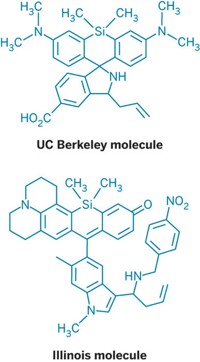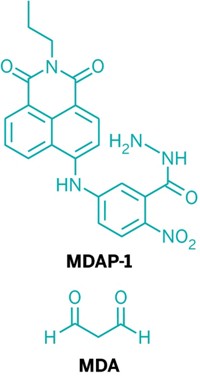Advertisement
Grab your lab coat. Let's get started
Welcome!
Welcome!
Create an account below to get 6 C&EN articles per month, receive newsletters and more - all free.
It seems this is your first time logging in online. Please enter the following information to continue.
As an ACS member you automatically get access to this site. All we need is few more details to create your reading experience.
Not you? Sign in with a different account.
Not you? Sign in with a different account.
ERROR 1
ERROR 1
ERROR 2
ERROR 2
ERROR 2
ERROR 2
ERROR 2
Password and Confirm password must match.
If you have an ACS member number, please enter it here so we can link this account to your membership. (optional)
ERROR 2
ACS values your privacy. By submitting your information, you are gaining access to C&EN and subscribing to our weekly newsletter. We use the information you provide to make your reading experience better, and we will never sell your data to third party members.
Biological Chemistry
Peekaboo, H2O2
Pacifichem News: New probes unravel more of the reactive molecule’s biological roles
by Carmen Drahl
January 10, 2011
| A version of this story appeared in
Volume 89, Issue 2
Hydrogen peroxide can’t hide from Christopher J. Chang. For the past several years, he and his team at the University of California, Berkeley, have been developing new chemical tools to track the reactive small molecule in its common hangouts, such as mitochondria and live nerve cells.
Now, they’ve improved one of their established probes to shed light on how H2O2 helps stem cells in the brain grow, and they’ve found a way to track H2O2 in living mice. The work could help researchers learn more about H2O2’s many roles in biology. Chang presented the work at last month’s 6th International Chemical Congress of Pacific Basin Societies, or Pacifichem, held in Honolulu.
H2O2 contributes to inflammation and diseases such as stroke. But work from several labs is pointing to the molecule’s more beneficial roles, Chang says. His team is interested in how H2O2 can act as a biochemical signal. They’ve chosen brain stem cells as a starter testing ground for two reasons: first, for their relevance to regenerative medicine and second, for their simplicity as an experimental system. Because H2O2 is a molecular signal for growth in cultured cells, it’s relatively easy to study signaling by keeping tabs on stem cell growth, Chang explains.
But monitoring H2O2 signaling in stem cells was impossible with his team’s existing tool kit, Chang says. His team’s established sensors contain a fluorescent dye designed not to glow until it comes in contact with H2O2. The dye is masked with a boronic acid group that only H2O2 can remove. But none of those H2O2 sensors was sensitive enough.
Chang’s former graduate student Bryan C. Dickinson, now a postdoctoral fellow at Harvard University, was inspired by other teams’ work suggesting that making the probe stick around inside cells as long as possible would boost sensitivity, and he found a fix: a negatively charged probe with acetoxymethyl caps. Negatively charged molecules can’t cross the cell membrane on their own, but the caps enable the probe to traverse the barrier with ease. Once inside a cell, esterase enzymes remove the caps, making the probe negatively charged, effectively trapping it inside and allowing it to build up in terms of concentration, Chang says. “It’s a relatively simple chemical change that allows us to detect lower peroxide levels than we could before,” he says.
With the new probe, Chang, Dickinson, and coworkers in Berkeley chemical engineer David V. Schaffer’s lab learned that an enzyme called Nox2 is a major regulator of brain stem cell growth through its production of H2O2 (Nat. Chem. Biol., DOI: 10.1038/nchembio.497). This could explain why mice and humans that lack Nox2 have cognitive defects, Chang says.
As useful as stem cells are, sometimes a study in a living animal is the best way to answer a scientific question. Tools for tracking H2O2 in live animals are scarce, however, and the best of those requires removing a mouse’s skin to detect signals.
At Pacifichem, Chang also described the first H2O2 probe from his team that works in living mice, with no fur or skin removal necessary. It’s based on luciferin, a light-producing molecule from fireflies that scientists use to monitor events as varied as gene expression and protease enzyme action.
Graduate student Genevieve C. Van de Bittner developed the probe with help from Elena A. Dubikovskaya, a postdoctoral researcher from Carolyn R. Bertozzi’s Berkeley lab. They masked luciferin with an aromatic boronic acid group that only H2O2 can remove. Once unmasked, the luciferin probe generates light if exposed to the enzyme luciferase, which the mice the team employed are engineered to make. “It’s a big technology advance for us to show that the chemistry we were using for selective detection at the cellular level could be transferred to the whole-animal level,” Chang says.
With the new system, the team could “see” H2O2 in a mouse’s major organs, including the heart and liver, and learned that prostate tumors in mice increase their H2O2 production in response to testosterone (Proc. Natl. Acad. Sci. USA, DOI: 10.1073/pnas.1012864107). Although it’s not surprising that a tumor might have heightened oxidative stress (caused by overproduction of reactive oxygen species such as H2O2), seeing the peroxide aspect of that stress unfold in living animals provides strong evidence that it’s actually occurring, Chang says.
The new probes are already helping to illuminate biology, says Georgia Institute of Technology’s Niren Murthy, who also develops H2O2-imaging tools. Little was previously known about Nox2’s role in the brain stem cell system Chang studied, and the luciferin probe, despite requiring a mouse that makes luciferase, can answer questions other probes can’t. “Until now no one’s been able to measure peroxide in a tumor,” Murthy says.
University of California, Merced, biochemist Henry J. Forman, who studies reactive oxygen species, praised the team’s advances but cautioned that the luciferin probe is unlikely to be detecting H2O2 inside cells and is more likely to be detecting it in spaces outside of cells in the mouse’s body. Inside cells, he says, the probe must compete for peroxide with enzymes, such as glutathione peroxidases, that interact with H2O2 far more rapidly.
It’s tough to tell for sure whether the luciferin probe can see H2O2 inside cells, Chang says. Unlike the stem cell probe, which accumulates in cells, the luciferin probe can freely diffuse in and out of cells, so it’s not clear where a signal originates, he says. In an effort to answer this question, the team performed a control with catalase, an enzyme that quickly decomposes H2O2, and still detected an appreciable signal from the luciferin probe. On the basis of that result, the researchers thought it was a reasonable assumption that they could detect H2O2 both inside and outside the cells of living animals, Chang explains.
Murthy doesn’t think that competing species inside cells completely prevent Chang’s luciferin probe from working there. But in any case, the work should inspire chemists to make even better sensors, he says. “We want to learn as much as possible about the role of peroxide in biology and see if we can use probes for detecting diseases,” Murthy says. “I think this work is on the right track.”






Join the conversation
Contact the reporter
Submit a Letter to the Editor for publication
Engage with us on Twitter